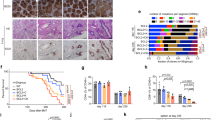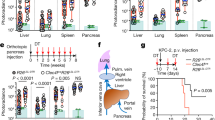Abstract
The majority of patients with acute myeloid leukemia (AML) still die of their disease, and novel therapeutic concepts are needed. Timely expression of the hematopoietic master regulator PU.1 is crucial for normal development of myeloid and lymphoid cells. Targeted disruption of an upstream regulatory element (URE) located several kb upstream in the PU.1 promoter decreases PU.1 expression thereby inducing AML in mice. In addition, suppression of PU.1 has been observed in specific subtypes of human AML. Here, we identified nuclear factor-κB (NF-κB) to activate PU.1 expression through a novel site within the URE. We found sequence variations of this particular NF-κB site in 4 of 120 AML patients. These variant NF-κB sequences failed to mediate activation of PU.1. Moreover, the synergistic activation of PU.1 together with CEBPB through these variant sequences was also lost. Finally, AML patients with such variant sequences had suppressed PU.1 mRNA expression. This study suggests that changes of a single base pair in a distal element critically affect the regulation of the tumor suppressor gene PU.1 thereby contributing to the development of AML.
This is a preview of subscription content, access via your institution
Access options
Subscribe to this journal
Receive 50 print issues and online access
$259.00 per year
only $5.18 per issue
Buy this article
- Purchase on Springer Link
- Instant access to full article PDF
Prices may be subject to local taxes which are calculated during checkout





Similar content being viewed by others
References
Anderson KL, Smith KA, Pio F, Torbett BE, Maki RA . (1998). Neutrophils deficient in PU.1 do not terminally differentiate or become functionally competent. Blood 92: 1576–1585.
Back J, Allman D, Chan S, Kastner P . (2005). Visualizing PU.1 activity during hematopoiesis. Exp Hematol 33: 395–402.
Chen HM, Zhang P, Voso MT, Hohaus S, Gonzalez DA, Glass CK et al. (1995). Neutrophils and monocytes express high levels of PU.1 (Spi-1) but not Spi-B. Blood 85: 2918–2928.
Cook WD, McCaw BJ, Herring C, John DL, Foote SJ, Nutt SL et al. (2004). PU.1 is a suppressor of myeloid leukemia, inactivated in mice by gene deletion and mutation of its DNA binding domain. Blood 104: 3437–3444.
Ebralidze AK, Guibal FC, Steidl U, Zhang P, Lee S, Bartholdy B et al. (2008). PU.1 expression is modulated by the balance of functional sense and antisense RNAs regulated by a shared cis-regulatory element. Genes Dev 22: 2085–2092.
Friedman AD . (2007). C/EBPalpha induces PU.1 and interacts with AP-1 and NF-kappaB to regulate myeloid development. Blood Cells Mol Dis 39: 340–343.
Furman RR, Asgary Z, Mascarenhas JO, Liou HC, Schattner EJ . (2000). Modulation of NF-kappa B activity and apoptosis in chronic lymphocytic leukemia B cells. J Immunol 164: 2200–2206.
Ghosh G, van Duyne G, Ghosh S, Sigler PB . (1995). Structure of NF-kappa B p50 homodimer bound to a kappa B site. Nature 373: 303–310.
Guzman ML, Neering SJ, Upchurch D, Grimes B, Howard DS, Rizzieri DA et al. (2001). Nuclear factor-kappaB is constitutively activated in primitive human acute myelogenous leukemia cells. Blood 98: 2301–2307.
Hromas R, Orazi A, Neiman RS, Maki R, Van Beveran C, Moore J et al. (1993). Hematopoietic lineage-restricted and stage-restricted expression of the ETS oncogene family member PU.1. Blood 82: 2998–3004.
Huang G, Zhang P, Hirai H, Elf S, Yan X, Chen Z et al. (2008). PU.1 is a major downstream target of AML1 (RUNX1) in adult mouse hematopoiesis. Nat Genet 40: 51–60.
Hoogenkamp M, Krysinska H, Ingram R, Huang G, Barlow R, Clarke D et al. (2007). The PU.1 locus is differentially regulated at the level of chromatin structure and non-coding transcription by alternate mechanisms at distinct developmental stages of hematopoiesis. Mol Cell Biol 27: 7425–7438.
Klemsz MJ, McKercher SR, Celada A, Van Beveren C, Maki RA . (1990). The macrophage and B cell-specific transcription factor PU.1 is related to the ets oncogene. Cell 61: 113–124.
Kleinjan DA, van Heyningen V . (2005). Long-range control of gene expression: emerging mechanisms and disruption in disease. Am J Hum Genet 76: 8–32.
Kordes U, Krappmann D, Heissmeyer V, Ludwig WD, Scheidereit C . (2000). Transcription factor NF-kappaB is constitutively activated in acute lymphoblastic leukemia cells. Leukemia 14: 399–402.
Kummalue T, Friedman AD . (2003). Cross-talk between regulators of myeloid development: C/EBPalpha binds and activates the promoter of the PU.1 gene. J Leukoc Biol 74: 464–470.
Kunsch C, Ruben SM, Rosen CA . (1992). Selection of optimal kappaB/Rel DNA-binding motifs: interaction of both subunits of NF-kappaB with DNA is required for transcriptional activation. Mol Cell Biol 12: 4412–4421.
Landry JR, Mager DL, Wilhelm BT . (2003). Complex controls: the role of alternative promoters in mammalian genomes. Trends Genet 19: 640–648.
Li Y, Okuno Y, Zhang P, Radomska HS, Chen H, Iwasaki H et al. (2001). Regulation of the PU.1 gene by distal elements. Blood 98: 2958–2965.
Matsusaka T, Fujikawa K, Nishio Y, Mukaida N, Matsushima K, Kishimoto T et al. (1993). Transcription factors NF-IL6 and NF-kappa B synergistically activate transcription of the inflammatory cytokines, interleukin 6 and interleukin 8. Proc Natl Acad Sci USA 90: 10193–10197.
McKercher SR, Torbett BE, Anderson KL, Henkel GW, Vestal DJ, Baribault H et al. (1996). Targeted disruption of the PU.1 gene results in multiple hematopoietic abnormalities. EMBO J 15: 5647–5658.
Mueller BU, Pabst T, Fos J, Petkovic V, Fey MF, Asou N et al. (2006). ATRA resolves the differentiation block in t(15;17) acute myeloid leukemia by restoring PU.1 expression. Blood 107: 3330–3338.
Mueller BU, Pabst T, Osato M, Asou N, Johansen LM, Minden MD et al. (2002). Heterozygous PU.1 mutations are associated with acute myeloid leukemia. Blood 100: 998–1007.
Nerlov C, Graf T . (1998). PU.1 induces myeloid lineage commitment in multipotent hematopoietic progenitors. Genes Dev 12: 2403–2412.
Nijnik A, Mott R, Kwiatkowski DP, Udalova IA . (2003). Comparing the fine specificity of DNA binding by NF-kappaB p50 and p52 using principal coordinates analysis. Nucleic Acids Res 31: 1497–1501.
Nutt SL, Metcalf D, D’Amico A, Polli M, Wu L . (2005). Dynamic regulation of PU.1 expression in multipotent hematopoietic progenitors. J Exp Med 201: 221–231.
Okuno Y, Huang G, Rosenbauer F, Evans EK, Radomska HS, Iwasaki H et al. (2005). Potential autoregulation of transcription factor PU.1 by an upstream regulatory element. Mol Cell Biol 25: 2832–2845.
Paz-Priel I, Cai DH, Wang D, Kowalski J, Blackford A, Liu H et al. (2005). CCAAT/enhancer binding protein alpha (C/EBPalpha) and C/EBPalpha myeloid oncoproteins induce bcl-2 via interaction of their basic regions with nuclear factor-kappaB p50. Mol Cancer Res 10: 585–596.
Rosenbauer F, Owens BM, Yu L, Tumang JR, Steidl U, Kutok JL et al. (2006). Lymphoid cell growth and transformation are suppressed by a key regulatory element of the gene encoding PU.1. Nat Genet 38: 27–37.
Rosenbauer F, Wagner K, Kutok JL, Iwasaki H, Le Beau MM, Okuno Y et al. (2004). Acute myeloid leukemia induced by graded reduction of a lineage-specific transcription factor, PU.1. Nat Genet 36: 624–630.
Schmitz ML, Baeuerle PA . (1991). The p65 subunit is responsible for the strong transcription activating potential of NF-kappa B. EMBO J 10: 3805–3817.
Scott EW, Simon MC, Anastai J, Singh H . (1994). The transcription factor PU.1 is required for the development of multiple hematopoietic lineages. Science 265: 1573–1577.
Steidl U, Steidl C, Ebralidze A, Chapuy B, Han HJ, Will B et al. (2007). A distal single nucleotide polymorphism alters long-range regulation of the PU.1 gene in acute myeloid leukemia. J Clin Invest 117: 2611–2620.
Stein B, Cogswell PC, Baldwin AS . (1993). Functional and physical associations between NF-kappa B and C/EBP family members: a Rel domain–bZIP interaction. Mol Cell Biol 13: 3964–3974.
Suraweera N, Meijne E, Moody J, Carvajal-Carmona LG, Yoshida K, Pollard P et al. (2005). Mutations of the PU.1 Ets domain are specifically associated with murine radiation-induced, but not human therapy-related, acute myeloid leukaemia. Oncogene 19: 3678–3683.
Tisné C, Hartmann B, Delepierre M . (1999). NF-kappa B binding mechanism: a nuclear magnetic resonance and modeling study of a GGG → CTC mutation. Biochemistry 38: 3883–3894.
Udalova IA, Richardson A, Denys A, Smith C, Ackerman H, Foxwell B et al. (2000). Functional consequences of a polymorphism affecting NF-kappaB p50-p50 binding to the TNF promoter region. Mol Cell Biol 20: 9113–9119.
Voso MT, Burn TC, Wulf G, Lim B, Leone G, Tenen DG . (1994). Inhibition of hematopoiesis by competitive binding of the transcription factor PU.1. Proc Natl Acad Sci USA 91: 7932–7936.
Yeamans C, Wang D, Paz-Priel I, Torbett BE, Tenen DG, Friedman AD . (2007). C/EBPalpha binds and activates the PU.1 distal enhancer to induce monocyte lineage commitment. Blood 110: 3136–3142.
Acknowledgements
This work was supported by a grant from the Swiss National Science Foundation SF 310000-113761 (to BUM), and a grant from the Swiss Cancer League, OCS 01731082005 (to BUM).
Author information
Authors and Affiliations
Corresponding author
Rights and permissions
About this article
Cite this article
Bonadies, N., Neururer, C., Steege, A. et al. PU.1 is regulated by NF-κB through a novel binding site in a 17 kb upstream enhancer element. Oncogene 29, 1062–1072 (2010). https://doi.org/10.1038/onc.2009.371
Received:
Revised:
Accepted:
Published:
Issue Date:
DOI: https://doi.org/10.1038/onc.2009.371
Keywords
This article is cited by
-
PU.1 supports TRAIL-induced cell death by inhibiting NF-κB-mediated cell survival and inducing DR5 expression
Cell Death & Differentiation (2017)
-
Chronic interleukin-1 exposure drives haematopoietic stem cells towards precocious myeloid differentiation at the expense of self-renewal
Nature Cell Biology (2016)
-
Fumarates modulate microglia activation through a novel HCAR2 signaling pathway and rescue synaptic dysregulation in inflamed CNS
Acta Neuropathologica (2015)
-
Enhanced expression of trim14 gene suppressed Sindbis virus reproduction and modulated the transcription of a large number of genes of innate immunity
Immunologic Research (2015)
-
Dual regulation of SPI1/PU.1 transcription factor by heat shock factor 1 (HSF1) during macrophage differentiation of monocytes
Leukemia (2014)



